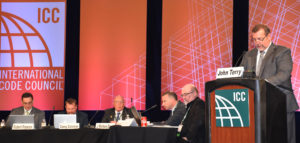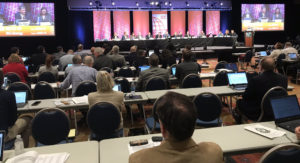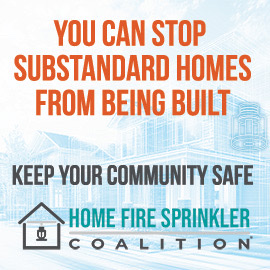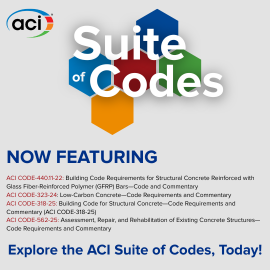
Energy efficiency, sustainability results from the Committee Action Hearings
The 2019 Committee Action Hearings took place April 28 through May 8, 2019, in Albuquerque, N.M., to consider proposed changes to the Group B International Codes. The second in the 2021 code development cycle, the hearings saw action on more than 1,300 code change proposals and nearly 185 hours of testimony in two hearing tracks during the 11 days in Albuquerque.
Energy and green construction codes are gaining more prominence across the nation and around the world as the building industry rapidly moves in the direction of sustainable, resilient and energy-efficient high-performance buildings. A thoughtful, whole building design approach can serve as a straightforward and effective framework for architects and designers, developers and even the community at large in crafting sustainability initiatives that drive more resilient development and help cities achieve economic prosperity. The Group B Codes considered in Albuquerque included the International Energy Conservation Code (commercial and residential energy provisions) and the International Green Construction Code (Chapter 1).
Here are some of the biggest takeaways regarding energy efficiency and sustainability from the 2019 Committee Action Hearings.
International Energy Conservation Code — commercial provisions
The IECC–Commercial Committee approved a variety of proposals offering increased energy efficiency and structural changes to the code.
Increased efficiency can be expected from increased lighting efficacy and decreased lighting power density requirements (CE162, CE206 and CE208). New provisions for controlled receptacles were approved, requiring automatic controls for 50 percent of receptacles in enclosed offices, conference rooms, break rooms, copy rooms and classrooms; this is the first provision in the code addressing plug loads (CE216). Envelope leakage testing and verification requirements were extended to include buildings other than Group R and Group I occupancies with exceptions based on building size and climate zone (CE97 and CE99).
Structural and efficiency changes were made to Section C406, expanding the options provided and moving compliance via a flexible point-based structure (CE218, 226, 229, 235 and 240). New provisions in the code include new definitions for electric vehicles (EV) and requirements for EV-ready and EV-capable spaces (CE217), and a commercial zero code renewable appendix was approved with the passage of CE264.
A proposal submitted by the Code Council Sustainability, Energy and High Performance Code Action Committee (SEHPCAC) clarifying the compliance paths through a simple naming of each path, consistent use of each name and clarifying the requirements for each path within the regulations of each path (CE41) was approved. Both the commercial and residential committees passed proposals redefining and expanding climate zones to include CZ0, approximately 200 counties were given warmer climate zone designations (CE36 Parts I and II), and the commercial and residential committees approved a comprehensive proposal submitted by SEHPCAC addressing the use of terms “mandatory” and “prescriptive”. The proposal developed tables of required (non-tradable) provisions for each compliance path, eliminating the use of the terms “mandatory” and “prescriptive” throughout the IECC (CE42 Parts I and II).
International Energy Conservation Code — residential provisions
The IECC–Residential Committee favored moderate increases in energy efficiency, while narrowly disapproving significant structural and efficiency increases. Moderate structural and clarification proposals were approved. Repeatedly the committee sought transparent cost effectiveness and energy efficiency analysis in making their decisions.
Increases in energy efficiency can be expected through increased lighting efficacy requirements (RE7), decreases in fenestration U-factors (RE35), duct tightness testing (RE112 and RE115) and an increased SHGC backstop (RE105). In addition, heat recovery ventilation/energy recovery ventilation requirements in northern climate zones 7 and 8 were approved (RE139), and controls for exterior lighting (RE149).
Significant structural and/or efficiency increases that were disapproved either by the committee or at the request of the proponent to further refine through public comments included proposals offered to provide a menu of point-based options for additional requirements. These included proposals submitted by the Energy Efficiency Codes Coalition (RE206), New Buildings Institute (RE207), Leading Builders of America (RE208) and the Alliance to Save Energy (RE209). A Zero-Energy Appendix based on Energy Rating Index scores and EV-ready requirement proposals were also disapproved.
Finally, in addition to the structural changes common to both the commercial and residential provisions noted above, a proposal submitted by SEHPCAC clarifying the compliance paths through a simple naming of each path, consistent use of each name, and clarifying the requirements for each path (RE15) was approved.
International Green Construction Code
With the development and publication of the 2018 edition of the International Green Construction Code (IgCC), the code transitioned to be based on the technical requirements of the 2017 edition of ANSI/ASHRAE/ICC/USGBC/IES Standard 189.1 and the Chapter 1 Administrative Provisions based on the 2015 IgCC. The 2019 cycle is the first cycle where code changes were submitted to the Code Council’s code development process to update Chapter 1 of the 2021 IgCC. The technical requirements of the 2021 IgCC will be based on the 2020 edition of Standard 189.1. For more information, be sure to consult the preface of the 2018 IgCC.
Proposal GG3–19, recommended for approval as modified, is intended to increase adoptions of the IgCC. It is based on a concept initiated by SEHPCAC, which was then submitted to the Standing Standards Project Committee 189.1. As noted above, Standard 189.1 is the basis for the technical requirements of the IgCC (Chapters 2 through 11).
The proposal provides a table with a list of items that jurisdictions can opt out of. All other requirements of the code are considered core requirements and must be complied with. Jurisdictions can check boxes in the list to opt out of various requirements, thus streamlining green building requirements and reducing barriers to adoption of the code. Jurisdictions can start with a simplified, yet effective, green building code and move to more stringent requirements, if they so choose, at a later time. The list also allows jurisdictions to opt out of requirements that may not be appropriate or critical for their particular region.
The Standard 189.1 Committee is in the process of reviewing SEHPCAC’s concept. It is important to note, as indicated in the staff analysis to some of the IgCC proposals (GG3 included), the final action on the proposed revisions will require correlation with those of the update of Standard 189.1 to avoid conflicting provisions.
The next phase
Here are some dates and information to keep in mind.
2019 Group B Report of Committee Action Hearing is posted
The 2019 Group B Report of Committee Action Hearing from the meeting in Albuquerque, N.M., are available. Click here for the results.
2019 Group B Public Comment Hearing
The submittal of public comments for the 2019 Group B International Codes will be considered at the 2019 Group B Public Comment Hearings scheduled for Oct. 23–30, 2019, in Las Vegas, Nev.
2019 Group B Committee Action Hearing hearing videos
The over 1,300 code changes considered at the 2019 Committee Action Hearings have been captured on video. Click here to view the hearing videos.
Advocacy and the code development cycle
 The Code Council is the impartial convener of the code development process. Our job is to ensure a transparent process and to provide a space for balanced debate and deliberation on code change proposals. To that end, the Code Council has advocacy guidelines and procedures to guarantee a fair process. We rely on participants in this process to uphold themselves and their colleagues to the highest standards of professionalism and ethical behavior. To read our Code of Ethics, click here.
The Code Council is the impartial convener of the code development process. Our job is to ensure a transparent process and to provide a space for balanced debate and deliberation on code change proposals. To that end, the Code Council has advocacy guidelines and procedures to guarantee a fair process. We rely on participants in this process to uphold themselves and their colleagues to the highest standards of professionalism and ethical behavior. To read our Code of Ethics, click here.
Learn more about the code development process
The International Code Council’s code development process for the 2021 codes will take three years and is open, transparent and inclusive. To learn the basics of the code development process, check out our video, which is a good primer for those new to the process and explains ICC’s cloud-based system for the code development process — cdpACCESS — in terms everyone can understand.
For more information about the code development process, click here.
Download infographics about the process: How It Works and By the Numbers.
Click here to see photos from the 2019 Committee Action Hearings in Albuquerque.







